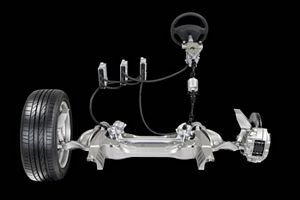|
By accessing or using The Crittenden Automotive Library™/CarsAndRacingStuff.com, you signify your agreement with the Terms of Use on our Legal Information page. Our Privacy Policy is also available there. |

Nissan steer by wire - Is it dangerous?
|
|---|
|
|
Nissan steer by wire - Is it dangerous?
Matt Hubbard
Speedmonkey
October 19, 2012
Nissan have announced that they will be selling cars whose steering will be electronically controlled, within a year.
The system works by sending electronic signals to an ECU that then controls the wheels. Nissan claims the new system will improve handling and feedback due to a faster response time between human inputs and actions at the wheel. A Nissan spokesman said:
"For example, even on a road surface with minor ridges or furrows, the driver no longer has to grip the steering wheel tightly and make detailed adjustments, so travelling on the intended path becomes easier."
Further, a Nissan Engineer, Masaharu Satou, said:
"If we are freed from that (mechanical control) we would be able to place the steering wheel wherever we like, such as in the back seat, or it would be possible to steer the car with a joystick."
Initially, Nissan will install a back-up clutch system which will mechanically link the steering wheel and tyres in the event of a problem - but they plan to drop this when the technology progresses.
So that's the plan is it? We already have drive by wire (in the new Honda CR-V) and brake by wire is not such a huge leap because the current technology is hydraulic, and therefore there is no physical link between the pedal and the brakes - aside from a liquid.
But, in our opinion, steer by wire is dangerous.
We are already seeing an infestation of electronic controls entering into our cars. Electronic parking brakes are the current big thing and can be seen in most new models - the new Golf will come with an electronic parking brake as standard.
Electric steering, with no mechanical control, is fine in ultra modern test cars in laboratories - or even when testing them in extreme conditions across the Mojavi desert or in Sweden - but these are new cars.
Nissan haven't accounted for two things. 1) Even new cars go wrong and, 2) Cars get old and people still drive them.
Just have a look at the recalls. Even Toyota, doyens of reliability, have undertaken a massive recall of their cars because window switches can stick and set on fire. Remember the sticking accelerator problem? People died because the accelerator stuck on and they ploughed helplessly into whatever solid object lay ahead of them. Although if your accelerator sticks on it is possible to do something about it such as putting the car in neutral, applying the brakes or even turning the engine off.
The point is when a manufacturer releases a new car, having tested it for millions of miles in all sorts of conditions, faults still arise after it has gone on sale.
And then we get to wear and tear. Sure, most countries have annual testing for cars - the UK has the annual MOT test - but will a 30 minute test be able to check for ageing wiring buried deep within the guts of the car. Will it be able to account for an auxiliary belt that suddenly snaps?
No, it won't. Cars age. Components fail. Batteries go flat - even on the move.
Would you really like to be driving a ten year old Nissan in 2025 with electronically controlled steering and no mechanical back-up? Think about it for a moment. Electronics need a source of power. Power can be diverted elsewhere, or fail to reach the electronic component that drives the wheels. You can then turn the steering wheel all you like but you will not be controlling the vehicle. You may be doing 70mph on a busy road. You may be halfway round your favourite, tree lined, corner.
The thought is horrendous.
If an accelerator sticks the car can be safely steered to the side side of the road. If the gearbox, or clutch fails the car can be safely steered to the side of the road. If the power steering fails the can can safely be steered (with some extra effort) to the side of the road. If a tyre bursts the car can be (reasonably) safely steered to the side of the road.
If the steering fails, what are you going to do? Jump out at 70mph?
All cars, from now until the point the car no longer exists, need to have a mechanical link between the steering system and the wheels. The steering is the last point of contact between a driver and control of his/her vehicle. Almost anything else can fail but the steering is the one thing that enables a driver to point a vehicles where it needs to go.
Steer by wire is a folly, an act of one-upmanship by Nissan. It is an interesting idea but it needs to be stopped. Now


















